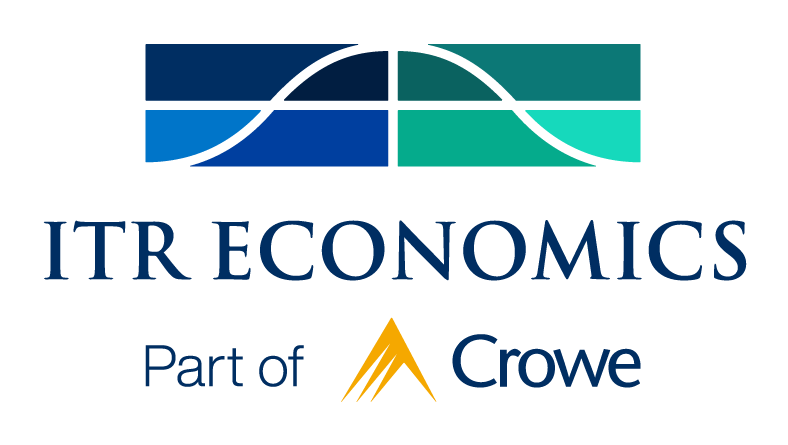March 24, 2025
- Home
- portfolio
- TrendsTalk
- March 24, 2025
TARIFF IMPACT AND KEY LEADING INDICATORS
This week on TrendsTalk, ITR Economist Taylor St. Germain discusses the impact of tariffs and leading indicators on the economy. Despite a sluggish start to 2025, will we see stronger economic growth in the second half of the year? Tune in to TrendsTalk to find out how these economic factors could affect your business!

MEET YOUR HOST
Taylor St. Germain
As an experienced economist, Taylor St. Germain provides consulting services for small businesses, trade associations, and Fortune 500 companies across a spectrum of industries. His dynamic personality and extensive knowledge of economic trends and their business relevance are highly valued by clients and colleagues alike.
“Join me on the TrendsTalk podcast to explore the world of economics. Episodes offer insightful discussion and expert interviews. We cover relevant economic concepts in an accessible way. Whether you are a curious layperson or an industry professional, TrendsTalk is your go-to source for thought-provoking analysis and a deeper understanding of the economic forces shaping our world.”
Key Episode Takeaways
- 0:07 – Beginning discussion on tariffs and leading indicators
- 0:51 – Tariff analysis and reviewing effects of 2018 tariffs
- 2:42 – Highlighting our 2025 economic outlook
- 3:54 – Reviewing key leading economic indicators
- 5:28 – Stock market warning and perspective
The below transcript is a literal translation of the podcast audio that has been machine generated by Notta.
Taylor St. Germain:
Hi, everyone. My name is Taylor St. Germain with ITR Economics, and welcome to this episode of TrendsTalk. We at ITR are your apolitical and unbiased source of economic intelligence. And today I wanted to talk about two things, tariffs and leading indicators. I know there’s a lot of uncertainty on everyone’s minds. If you’ve been watching the stock market, and you might be a little bit concerned, and I’m here to weed through some of that noise for you.
The first thing I wanted to highlight is a recent executive summary from our chief economist, Brian Beaulieu. He highlighted some of what I’ll be talking about today. So if you’d like to see some visuals, head over to our Trends Report and look at that executive summary.
Now, the very first thing I wanted to call out is tariffs. There’s a lot of concerns going on there that seems like the situation is evolving day by day. And so I wanted to highlight a few things that we understand at ITR. We have really studied the effects of the 2018 tariffs that were put in place by the first Trump administration. And here’s what we understand as a result of some of these past events. There are some industries that will win from the effects of tariffs. There are some industries that will lose.
I know there’s been a lot of reports about consumer spending consumption. Ultimately, the US consumer will not stop consuming because of tariffs. And from our perspective, that final demand remains in place. Now, tariffs do create additional inflation. But we already had some of that inflation built into our CPI and PPI forecasts, which we have talked about on previous episodes. Now, what we also understand is tariffs will slow the growth rate of the US economy. Now let me be clear the trade deficit has nothing to do with our outlook for the 2030s. That’s one of the other questions we often get. The budget deficit is what concerns us as it relates to the 2030s.
The other thing to consider here with tariffs the last main point I’m going to leave you with is the fact that the impacts of tariffs it’s going to matter more to our neighbors it’s going to impact our neighbors and trading partners more than the US and that’s just because of the relative importance of trade as a percent of GDP.
So what does this all mean? Well we already had a slower year in 2025 when you look at several of our major forecasts. We expect the first half of the year to be sluggish and then start to see a ramp up in the second half of the year, even with all of this tariff uncertainty going on. Most clients that I forecast have a slow start to 2025, most often characterized by phase A recovery, meaning growth rates are down below the year ago level, but steadily improving. And then by the second half of the year, the majority of the clients that we’re forecasting are poised for a much stronger second half of 2025.
So I wanted to highlight what we understand about tariffs. I wanted to highlight what that means for 2025. And it means a slower year, there’s a sluggish first half of the year, but the leading indicators that we have always relied on here at ITR are continuing to point to better times ahead in the second half of 2025.
There’s a couple of relationships that I’ll call out to you and they’re relationships we’ve talked about in the past. The very first series I’d love to call out is US Nondefense Capital Goods New Orders. Again, this is one of our Trends Report series. And really what it represents is business investment, CAPX spending. And there’s good news with this indicator, it just recently transitioned to phase B accelerating growth. So we’re starting to see CAPX business investment activity accelerating in its pace of rise.
Now, the leading indicator, one of the leading indicators that we use is our ITR leading indicator, which has an eight month lead time to this series, to that CAPX series. And the ITR leading indicator continues to improve. When given that eight month lead time, that points to better times ahead in the second half of 2025 for CAPX spending. That’s very encouraging news.
Another relationship I’d call out is total manufacturing new orders. Again, that series has recently transitioned to phase B accelerating growth, and we look at the total industry capacity utilization rate when we’re evaluating this series. It has about a five-month lead time, and that capacity utilization rate is rising. We’re utilizing more capacity, there’s more demand, and that tells us manufacturing new orders is going to continue to rise as we move into the second half of 2025.
So when we look at these big macroeconomic data series that matter the most to a lot of our clients, they’re rising, they’re growing in an accelerating manner, and the leading indicator suggests that acceleration is going to continue. I don’t want to minimize some of the uncertainty and pain that we’re going through in the economy when we look at the stock market, right? Well, the joke is that the stock market predicts 10 in every five recessions. And you might say, Taylor, that makes no sense. It’s not supposed to make sense. The stock market can go through its volatility and its corrections all while the economy grows. If you remember the first quarter of 2022, there was a pretty significant volatility in the stock market, but we were reaching record high GDP growth all throughout that time.
So be careful about associating what’s going on with the stock market to the broader macro economy, because that relationship isn’t as strong as you might think it is. We continue to look at the leading indicators. Yes, there’s tariffs that we’re dealing with. Yes, it’s going to bring on some additional inflation in a slower economy, but the leading indicators still point to much better times ahead, especially as we get to the second half of 2025.
And that’s what we’re here for. We’re here to remind you to look at the data, listen to what the data is telling you. And right now, the data is telling us, yes, slow start to the year, but better times ahead.
I hope you found this information helpful. Please remember to like and subscribe to TrendsTalk wherever you listen to your podcast. I’m looking forward to seeing you all in the next one. Thanks so much. Take care for now.





